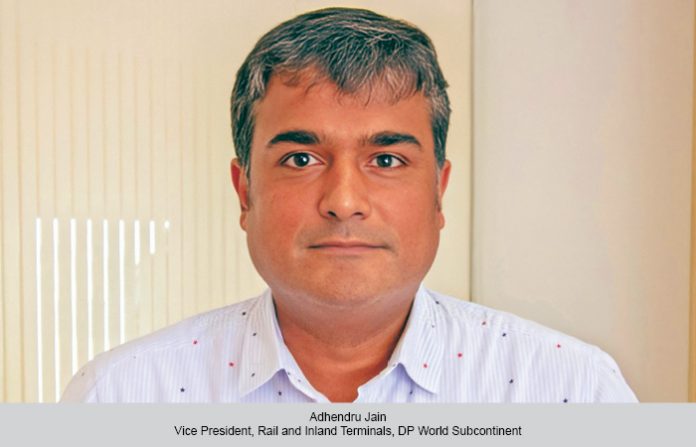An imbalance in cargo flow requires a strategic shift towards rail-based transportation. Integration of coastal, air, rail, and road modes into multimodal solutions promises a sustainable last-mile connectivity framework ensuring optimal service delivery, says Adhendru Jain, VP, Rail and Inland Terminals, DP World Subcontinent.
Ritika Arora Bhola
How much has DP World invested in integration of technology in enhancing rail logistics efficiency?
We have partnered with India in strengthening its logistics infra by developing multimodal logistics networks in India. Today, we have a sustainable end-to-end supply chain ecosystem linking the businesses from factory floor to customer’s door by investing in strategic assets. DP World Rail and Inland terminal is one of the largest private rail operators in India with seven rail-linked private freight terminals, operating 65 trains, with 14,000 container inventories, supporting movement for all types of cargo. Our rail logistics network is embedded with advanced technology to facilitate seamless transportation of cargo across India. Our system is equipped for 100 per cent online bookings, both domestic and EXIM cargo movement. DP World Logistics is the booking platform for customers, which gives 24×7 access of rate visibility and booking options. We have integrated all operational activities with Rail Management System and Yard Management System to ensure lean processes at all our terminals. With our real-time track and trace facility, customers have 24×7 visibility of their cargo.
Tell us about the initiatives taken to promote sustainability and cut emissions?
The government introduced the ‘National Rail Plan 2030’ to create a future ready railway system, aimed at reforming the Indian Railways. Making it more efficient, greener, and modern, translating it into a cost-efficient, safer, and assured mode of transport to the common man, be it in passenger or freight segment. Rail as a mode of transport is energy-efficient, emits less CO2 and consumes less energy. DP World’s new rail freight services, such as SARAL service, provide customers with 70 per cent reduction in emissions as compared to road transportation. We also launched a Carbon Emission Calculator for customers to know CO2 emission in kg for their mode of transportation. We also launched a Carbon Emission Profile, accredited with the global Smart Freight Centre (SFC) accreditation, and uses GLEC frameworks to calculate and inform shippers and consignees about emissions for their container movements.
The introduction of ‘open access sourcing of green power’ at DP World’s two terminals in Nhava Sheva (NSIGT and NSICT) will help replace 75 per cent of conventional electricity needs with green power, leading to 50 per cent reduction in emissions. Through innovative technologies and strategic partnerships such as these, we optimise operations for a greener future and advocate for climate action to ensure a greener future for
trade worldwide.
The government has introduced initiatives to boost rail logistics. What are your key expectations?
The Union Ministry of Railways’ transportation policy—under the Gati Shakti Multimodal Cargo Terminals initiative—aims to foster collaboration across transport sectors to enhance national connectivity. This initiative encourages private sector participation in establishing Gati Shakti Cargo Terminals (GCTs), with a target of 100 terminals by FY 2025, reflecting the government’s commitment to infrastructure development.
GCT initiative can aid in decongesting existing terminals, enhancing last-mile connectivity, and attracting new cargo to railways. Apart from increased opportunities across India using GCT terminals to be closer to production and consumption hub of customers, we expect participation in financing, constructing, and operating DFCs contributing to overall logistics improvement.
What are the challenges when it comes to cargo movement via rail? Enlarge on the likely solutions?
Enhancing the efficiency and reliability of rail cargo movement is crucial for optimising logistics in India. The government’s focus on creation of DFCs and MMLPs is aimed at improving the movement of cargo via rail. The 2024-25 Interim Budget for Indian Railways included the introduction of three new DFCs that will support multimodal connectivity. This will enable PPPs to boost infra development and improve efficiency of rail freight movement.
The establishment of the GCTs coupled with MMLPs expansion will enhance accessibility across India’s key industrial hubs, facilitating seamless cargo movement. Addressing an imbalance in cargo movement, evident in the major corridors of the North-East, requires a shift towards rail-based transportation, reducing reliance on road networks and fostering equilibrium in cargo movement dynamics. The integration of coastal, air, rail, and road modes into multimodal solutions promises a sustainable and efficient last-mile connectivity framework, ensuring optimal service delivery for customers nationwide.
How do you look at rail cargo operations five years hence in India? What are going to be the key megatrends?
Over the next five years, India’s rail cargo operations would be poised for a significant expansion, driven by key megatrends such as creation of DFCs, modernisation of operations, and a focus on infrastructure investment through PPPs. The Union Ministry of Railways has allocated ₹2.52 lakh crore for the fiscal year 2024-25, marking a 5.8 per cent increase from the previous year’s budget.
This heightened investment, coupled with an emphasis on PPPs, will catalyse substantial advancements in rail infrastructure, capacity, efficiency, and innovation. Strengthening of operations and development of better infrastructure will be pivotal to the growth of rail cargo, with targeted investments aimed at enhancing rail networks and facilities nationwide.
Aligned with the government’s agenda, DP World’s commitment to building a robust multimodal logistics supply chain network, including upcoming Free Trade Warehousing Zone in Cochin, Greenfield terminal in Tuna Tekra and a chemical-goods warehouse in Goa signify a concerted effort towards providing innovative solutions. By prioritising last-mile connectivity and facilitating seamless EXIM movement for cargo owners, DP World contributes to the overarching goal of enhancing India’s rail cargo operations. With a trajectory shaped by public-private collaborations, improved infrastructure, and heightened connectivity, the next five years promise a transformative journey for rail freight services in India.












